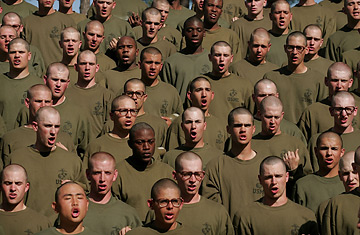
United States Marine Corps recruits recite answers to questions about Marine Corps history asked by their drill instructor during a break in training at boot camp at Parris Island, South Carolina.
Even as there's talk inside the Pentagon of extending the troop surge in Iraq well into 2008, the U.S. military remains in a vise, crushed between the demands of wars in Iraq and Afghanistan that have made recruiting more difficult. Right now, there are only two real ways to extend or even increase the surge: call up more reservists — always tough to do in an election year — or extend active-duty combat tours from the current morale-wrecking 15 months to an even more painful 18 months. But Marine General Peter Pace, outgoing chairman of the Joint Chiefs, reassured GIs in Afghanistan this week that 18-month combat tours are not, as has been rumored, in their future. "An 18-month tour has zero, zero, none, nada, squat, nothing, no validity, OK?" he said. "I want to make sure you got that."
So then what about the third, most controversial option — is it time to reinstitute the draft? That option has a certain appeal as the Army fell short of its active-duty recruiting goal for June by about 15%. It is the second consecutive month the service's enlistment effort has slipped as public discontent grows over the war in Iraq.
Bringing back mandatory service has been the refrain of many who want to put the brakes on the Iraq war; if every young man is suddenly a potential grunt on his way to Baghdad, the thinking goes, the war would end rather quickly. It's also an argument made by those who are uneasy that the burden of this war is being unfairly shouldered by the 1.4-million-strong U.S. military and no one else. But a new report from the Congressional Budget Office this week makes clear that resuming the draft would be no panacea.
The report, requested by Rep. John Murtha, D-Penn., chairman of the defense subcommittee of the House Appropriations Committee, says that drafting people could make it easier for the Army to reach its 2012 goal of 547,000 soldiers. It might also save some money if Congress opted to pay draftees less than volunteers. But the downside, the report claims, would be a less effective fighting force, thanks to a sudden influx of draftees who would remain in uniform for much shorter spells than today's all-volunteer soldiers.
"Usually, greater accumulated knowledge and skills come with increased experience," the report notes. "Because most draftees leave after completing a two-year obligation, a draft might affect the services' ability to perform those functions efficiently." To maintain the same capability, the CBO suggests, the Army might have to grow, which could eliminate any savings. On the other hand, increased training costs for draftees — with less time in uniform, more have to be trained — could be offset by cuts in advertising and bonuses now used to entice volunteer recruits.
The report says that while 91% of last year's recruits were high school graduates, only 80% of U.S. residents aged 18 to 24 have attained that level of education. And high school graduates, the military says, make better soldiers than dropouts. The CBO, which does not make recommendations but only charts options for lawmakers, estimates that somewhere between 27,000 and 165,000 would be drafted each year. That relatively small slice — some 2 million males turn 18 each year — could resurrect the problems seen in the Vietnam era when deferments and friendly draft boards kept some well-connected young men out of uniform. Under current law, women could not be drafted.
If it doesn't make military or economic sense to launch the draft, what about the notion of fairness? Critics have claimed that minorities are over-represented in the all-volunteer military because they have fewer options in the civilian world. The CBO disputes that, saying that "members of the armed forces are racially and ethnically diverse." African Americans accounted for 13% of active-duty recruits in 2005, just under their 14% share of 17-to-49-year-olds in the overall U.S. population. And minorities are not being used as cannon fodder. "Data on fatalities indicate that minorities are not being killed [in Iraq and Afghanistan] at greater rates than their representation in the force," the study says. "Rather, fatalities of white service members have been higher than their representation in the force," in large part because whites are over-represented in the military's combat, as opposed to support, jobs.
